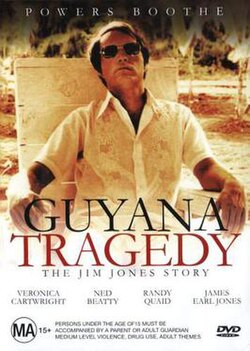Guyana Tragedy: The Story of Jim Jones
| Guyana Tragedy | |
|---|---|

Australian DVD cover
|
|
| Genre | Biography Drama |
| Directed by | William A. Graham |
| Starring |
Powers Boothe Ned Beatty LeVar Burton Colleen Dewhurst Randy Quaid Veronica Cartwright James Earl Jones |
| Composer(s) | Elmer Bernstein |
| Country of origin | United States |
| Original language(s) | English |
| Production | |
| Executive producer(s) | Frank Konigsberg |
| Producer(s) |
Sam Manners Ernest Tidyman |
| Cinematography | Gil Hubbs |
| Editor(s) |
Tony de Zarraga Aaron Stell |
| Running time | 192 minutes |
| Production company(s) | Konigsberg Company |
| Distributor | CBS |
| Release | |
| Original network | CBS |
| Original release |
|
Guyana Tragedy: The Story of Jim Jones, also called The Mad Messiah, is a 1980 television miniseries about the Peoples Temple led by Jim Jones, and their 1978 mass suicide at Jonestown. Based on the book by Charles A. Krause, entitled Guyana Massacre: The Eyewitness Account, the film was originally shown on television on April 15, 1980.
The film draws on Guyana Massacre: The Eyewitness Account and reports from The Washington Post at the time, to describe the life of Jim Jones from a 1960s idealist to the November 1978 mass murder/suicide of members of Peoples Temple in Jonestown, Guyana. In the beginning of the film, Jim Jones is seen helping minorities and working against racism. Later, after a move to San Francisco and increased power and attention, Jones becomes focused on his belief in nuclear holocaust, and moves hundreds of his followers to Guyana. Congressman Leo J. Ryan is notified that some individuals are being held against their will, and after going to investigate, the Guyana tragedy itself is depicted.
Jones's family members in the movie are based directly on his own family. The characters of Clayton and Jean Richie are based on Timothy and Grace Stoen (he was a primary Temple attorney and Jones's former right-hand man, she a main organizer for the Temple's "Planning Commission"), and David Langtree on Larry Schacht (the sole doctor at Jonestown), though elements of other Temple members are added to each, and details are changed. Many of the other characters are composites of one or more persons.
Though not a documentary in its own right, the film takes the style of a "true life" portrayal of the events.James Earl Jones appears in the film, as spiritual leader Father Divine. The final scenes of the film, with dialog taken from the infamous "Jonestown death tape" (FBI Number Q 042), were produced in a documentary cinematic style, and shot in Puerto Rico and Georgia instead of Guyana. The film was originally broadcast in two parts by CBS Television, on April 15 and 16.
...
Wikipedia
